Coins Overview
Few countries display a large variety of coinage like India when it comes to minting techniques, motifs, shapes, sizes or metal. A coin is essentially a piece of metal that has been inscribed and issued under the order of the ruling authority. It serves as legal tender in the region where it was issued. It is primarily used as a medium of exchange. But coins meant for collecting or kept as a token are also found, although these coins may not have been legal tender.
What is a coin?
A coin is a piece of metal stamped with an official design and/or inscription issued by the ruling authority of the region. It serves as legal tender for the country, kingdom or region. Coins have standardized weight and are issued in a mint in large quantities. They are usually round in shape but have been known to be minted in many different shapes in the past. They used for daily transactions and are being circulated in addition to banknotes.
What to look for in a coin?
Over the course of history, many rulers and dynasties have come and gone. Each has issued coins; sometimes bearing different designs. The ruler’s name or an epithet is usually minted on the coin barring some ancient coins. The obverse and reverse of the coins bear different devices. The legend on Indian coins are inscribed in Brahmi, Kharoṣṭhī, Greek, Arabic, Telugu, Kannada, Nagari and Sharada among other scripts. Modern coins may bear a security edge.
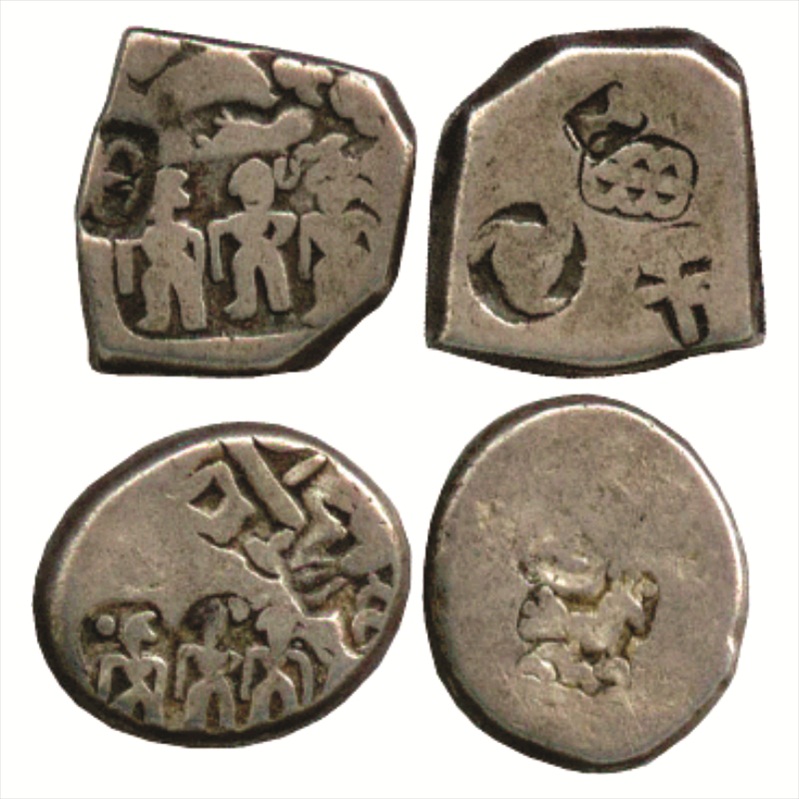
Punch-Mark Coins
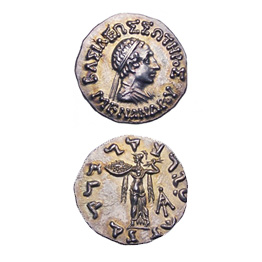
Silver Coin issued by Menander
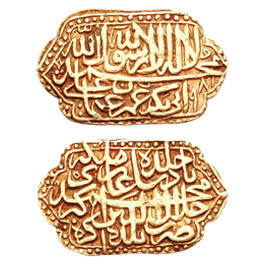
Mehrabi Coin issued by Akbar
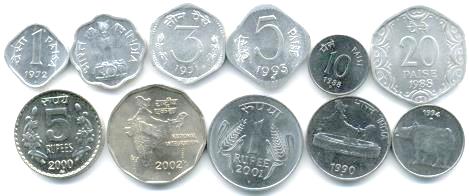
Modern Coins of India
We don't know for sure, but coins are known to have been minted since before 5th Century CE. The earliest known coins are Punch-Marked coins and were issued in Silver and Copper. They bore devices of animal and plant symbols.
The Indo-Greek coins were the first in India to bear the ruler's portrait on the obverse and a deity's figure on the reverse. The entire history of the Indo-Greek rule was discovered and constructed with the help of their coins.
Medieval Indian coins minted by the Delhi Sultanate and Mughals lack image motifs, except for a few coins issued by Akbar and Jehangir. Tipu Sultan is also known to have issued coins bearing the image of an elephant.
Republic Indian coins depict the essence of India today. Motifs such as ears of corn, the Indian Parliament, the map of India, the National Emblem and the Rhinoceros can be seen on coins. The various motifs on coins issued in India display the cultural impact of the period.
How are coins minted?
Coins are made from metal. The metal is first heated. The molten metal is then beaten into sheets. Planchets or coin blanks are cut from these sheets and the stamped with the chosen motif. There are 4 ways in which Indian coins have been minted over time.
- Punch Mark Technique
- Cast Technique
- Die-Struck Technique
- Repoussé Technique
Coins have played a vital role in a kingdom, state or a country's economy. Historic coins reveal political and economic information of the region it belonged to at the time. E.g. Indo-Greek presence in north-western India was confirmed through coins discovered in the area. Each ruler from the numerous dynasties in India over the ages, have issued a variety of coins. Many display excellent artistic merit. Coins were minted in Gold, Silver, Copper and Lead. Today, alloys like Cupro-Nickel and Stainless Steel are used to mint coins. Bronze and Aluminium-Magnesium were also used.
Ancient Punch-Mark coins bear punches of various designs. Die-struck coins bore a design that was carved fully on the mould, unlike Punch-Mark coins which were punched. Die-Struck coins bore designs depicting motifs of kings and goddesses. Coins issued during the medieval era display Islamic influence. Ancient, Medieval and Pre-Colonial era foreign coin hoards reveal trade patterns of India over time.
Weight
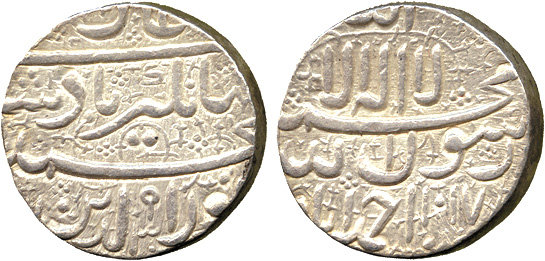
Jehangiri issued by Jehangir from Ahmedabad Mint
For example, Akbar had issued a gold mohur that weighed much more than the usual standard. Jehangir issued a Silver coin that also weighed more than the standard weight. This coin was known as Jehangiri.
Rarity
Rarity of a coin depends on the number of the type in circulation. If the number of coins belonging to a type is more, then the coin's rarity is common. If the coin is of a unique type or has limited pieces belonging to that type, then the coin is termed as rare. Rare coins are difficult to come across and are rarely photographed, but their value remains high in the market.
Collections and Auctions
Coin collectors usually focus on dynasties, rulers or types. A collection is complete if it includes coins of the same type belonging to different rulers or a coin of each type issued by a ruler or the dynasty. Coin collecting differs from Numismatics as it does not include studying the currency, but only collecting it. A numismatist may or may not be a coin collector and a collector may or may not be a numismatist.
Numerous numismatic auction houses have been catering to the numismatic community for a while now. They are the ones to go to if you wish to add a rare coin to your collection or start one. Common coins can be found with all coin dealers, however, rare coins are usually found only with auction houses. Auction houses have coin catalogues to help you identify and choose the coin you would like to buy. It is not, however, similar to a coin shop. If you wish to buy a coin from the auction house, you will be required to place a bid. The auctions may be conventional, silent or online. Almost all auction houses have established their presence on the internet and collectors and enthusiasts are able to place their bids from around the world at the click of a button.
